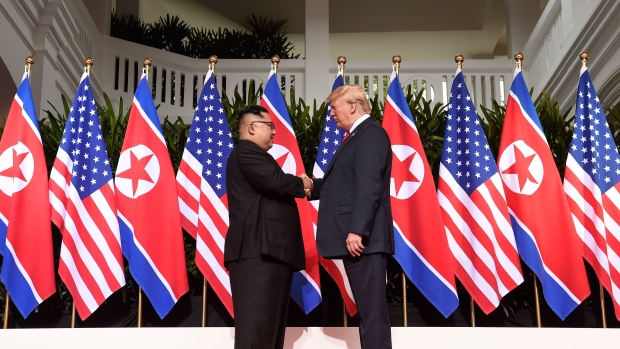Feb 19, 2019
Why North Korea May Give Up Its Nuclear Crown Jewel at Trump Summit
, Bloomberg News

(Bloomberg) -- For much of the past four decades, North Korea’s nuclear ambitions have focused on a sprawling complex nestled in the mountains north of Pyongyang. All of that could come to an end after President Donald Trump and leader Kim Jong Un meet next week.
The dismantlement of the Yongbyon Nuclear Scientific Research Center has emerged in recent months as a potential outcome from a second summit between the leaders planned for Feb. 27-28 in Vietnam. Moon Chung-in, a special adviser to South Korea’s president, told Bloomberg last week that Kim had agreed to close the plant and allow inspectors -- possibly giving the U.S. valuable insights into Kim’s weapons programs.
A deal to shutter Yongbyon would represent Trump’s first tangible victory toward reducing Kim’s nuclear capacity since he granted an unprecedented meeting last June -- even though North Korea has made similar promises before. The move could potentially deprive Kim of enough plutonium to make roughly one atomic bomb a year, and possibly other materials needed to make smaller, more powerful nuclear weapons.
Still, that would fall far short of the “final, fully verified denuclearization” that Secretary of State Michael Pompeo and other Trump administration officials have demanded. Even if he closes Yongbyon, arms control experts say Kim probably has at least one other secret plant that can produce enough uranium to make as many as six nuclear bombs a year.
Chun Yungwoo, a former South Korean nuclear envoy who helped broker one of the deals to shut Yongbyon, said the regime has shifted its focus to building better warheads and intercontinental ballistic missiles that could hit the U.S. North Korea probably has enough fissile material to continue most of its nuclear weapons program, even if it closed all its other fuel-production facilities, Chun said.
“Ten years ago, that was our main concern,” he said. “The relative value of Yongbyon and the enrichment plants outside of Yongbyon is now negligible.”
Still, Yongbyon, located about 100 kilometers (60 miles) north of the capital, carries symbolic value as the long-time crown jewel of North Korea’s nuclear weapons program. First constructed in 1979, its reactor has produced little electricity, but supplied the plutonium and research facilities needed for North Korea to test its first atomic bomb in 2006.
Kim Jong Un put Yongbyon back on the table in a meeting with South Korean President Moon Jae-in in September, when he expressed a willingness to accept the “permanent dismantlement” of the plant in exchange for “corresponding measures” by the U.S. Moon Chung-in, the president’s adviser, said Kim also agreed during that meeting to “accept verification” of its demolition.
Closing Yongbyon, as well as a lab that might produce tritium -- a radioactive isotope of hydrogen that helps in miniaturizing warheads -- would be a success, according to Siegfried Hecker, who was among a group of nuclear scientists who observed a uranium-enrichment operation at the facility during a 2010 inspection tour.
“Shutting down and dismantling the Yongbyon nuclear complex is a big deal,” said Hecker, who has visited the site four times. “It will stop the production of plutonium and tritium. And it will greatly diminish the ability to make highly enriched uranium.”
Still, inspecting the dozens of buildings at Yongbyon could take weeks and full dismantlement would drag on even longer. Disagreements might arise over how much of the complex is covered by any deal.
South Korea and other advocates of a gradual approach to talks with North Korea argue that Yongbyon’s dismantlement would build trust and encourage more significant concessions by Kim. The U.S.’s special representative for North Korea, Stephen Biegun, said last month that the North Korean leader has committed to the dismantlement of enrichment facilities “beyond Yongbyon” in conversations with Pompeo and South Korean officials.
How much Trump administration can accomplish by next week remains uncertain. Biegun told visiting South Korean lawmakers last week that it would be hard to resolve remaining disputes in advance and that talks were likely to stretch beyond the summit.
In exchange for dismantling Yongbyon, Kim would probably demand relief from international sanctions -- the U.S.’s main point of leverage in negotiations. The demolition would require delicate negotiations on where and when inspectors can roam, an area where similar talks collapsed a decade ago. The regime might divert nuclear materials to other facilities.
North Korea twice agreed to halt operations and let in nuclear inspectors in exchange for aid before Kim Jong Un took power, once in the mid-1990s and again in the mid-2000s. Both times, North Korea walked away and returned to military provocations after disagreements over how to implement the deal.
“We do want to make sure that the ‘shutdown of Yongbyon’ is as comprehensive as possible and as irreversible as possible,” said Melissa Hanham, a non-proliferation expert and director of the One Earth Future Foundation’s Datayo Project. “We don’t want to repeat the mistakes of the past.”
To contact the reporters on this story: Youkyung Lee in Seoul at ylee582@bloomberg.net;Jon Herskovitz in Tokyo at jherskovitz@bloomberg.net
To contact the editors responsible for this story: Brendan Scott at bscott66@bloomberg.net, Daniel Ten Kate
©2019 Bloomberg L.P.


